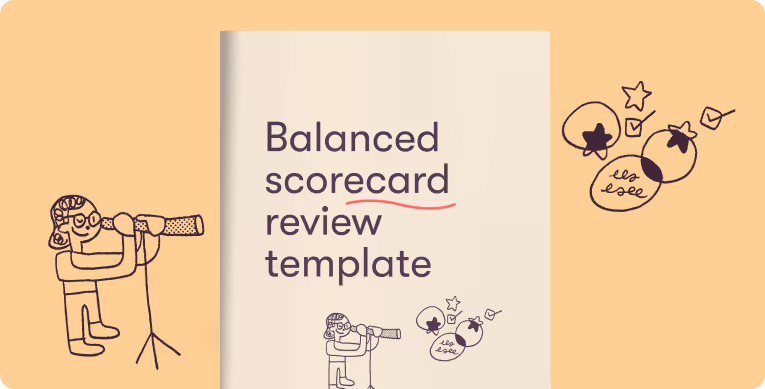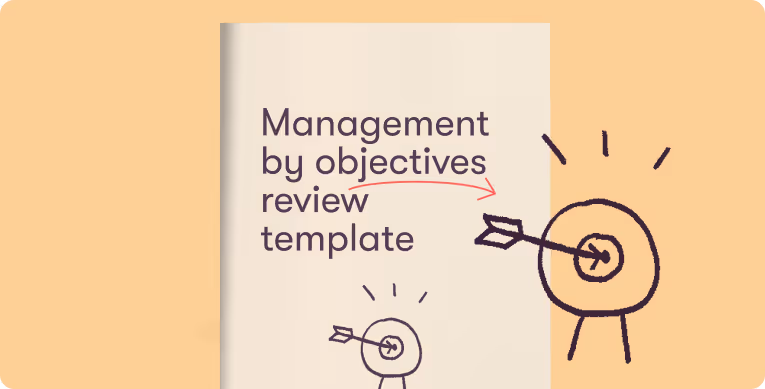6 Performance management template examples (and tips on how to use them)

Discover Workleap Officevibe's benchmark report on 12 key employee engagement metrics

Performance reviews are vital for gaining insights into employee performance, nurturing professional development, and driving organizational success. With well-structured reviews, you can ensure fair and consistent evaluations, facilitate open communication, and pinpoint areas for growth opportunities.
Reviews are key to empowering employees and enhancing overall team performance. They also help you enhance your own performance management process. However, it's important to note that reviews are just one tool in any leader's management arsenal and should be coupled with a number of other strategies for a holistic performance management approach.
We structured 6 different employee performance review templates for you to use, from the traditional annual or quarterly approach to project-based reviews! Scroll below.
The importance of an effective performance management template
A well-crafted performance review template drives success and growth for everyone involved. A template not only saves time but also ensures fairness by applying the same criteria to evaluate all employees consistently.
An efficient template helps identify strengths and areas for improvement, empowering employees to excel and grow. Additionally, it should support goal setting and career development and align individual objectives with the organization's mission. The structure should also promote open communication by creating moments that make feedback easy.
That being said, not all templates are created equally.
Understanding the different types of performance review templates
Understanding the different types of employee performance reviews allows you to tailor your evaluation processes to suit the unique needs of your organization. You can use one or a combination of several!
Annual performance review
Conducted once a year to evaluate an employee's overall yearly performance, including achieved goals, skill development, and areas for improvement. It serves as a guide for planning an employee's objectives and development opportunities for the upcoming year.
Semi-annual review
Typically occurs twice a year, in the middle and at the end of the fiscal year. It offers a mid-year assessment of the employee's progress toward goals, provides an opportunity for adjusting objectives, and acknowledges achievements. The semi-annual review facilitates timely feedback and allows for necessary course corrections.
Quarterly performance review
Takes place four times a year, aligning with the end of each business quarter. It offers more frequent feedback to employees, providing opportunities for performance improvements. By focusing on short-term goals and organizational objectives, this review helps keep employees aligned with the company's overall direction.
Project-based review
Usually done at the conclusion of a specific project or assignment and is sometimes referred to as a "retrospective." It evaluates an employee's performance by assessing the successful delivery of project outcomes and milestones achieved. This is great for creating a culture of continuous learning and encourages employees to gain valuable insights from project experiences to apply to the next project.
6 Performance review templates
The following templates offer diverse ways to evaluate and enhance employee performance. We're sure you're already using a few techniques in your performance management arsenal!
In each of the following templates, be sure to include administrative details at the top including employee name, department, and position, as well as the review period. Leave a section at the bottom for the reviewer's final thoughts and comments, as well as signatures.
#1: Traditional annual performance review template
Provides a comprehensive assessment of an employee's year-long performance. This review, conducted on an annual basis, delves into various aspects, including goal achievement, skill development, and areas for improvement.
To ensure a well-rounded evaluation, it often involves a rating system that measures performance against predefined goals and competencies:
- Example 5-Point Grading System
- Outstanding (5 points): The employee consistently exceeds all relevant performance standards. Provides leadership, fosters teamwork, is highly productive, innovative, responsive, and generates top-quality work.
- Exceeds Expectations (4 points): The employee consistently meets and often exceeds all relevant performance standards. Shows initiative and versatility, works collaboratively, has strong technical & interpersonal skills, or has achieved significant improvement in these areas.
- Meets Expectations (3 points): The employee consistently meets all relevant performance standards. Seldom exceeds or falls short of desired results or objectives.
- Below Expectations (2 points): The employee often falls short of meeting the minimum standards of job performance. Improvement is needed in specific areas.
- Unsatisfactory (1 point): The employee consistently fails to meet minimum performance standards. Immediate improvement is required.
Additionally, employees get a chance to reflect on their own performance through a self-assessment while supervisors provide valuable feedback.
The annual performance review concludes by setting new goals for the upcoming year and discussing exciting opportunities for professional growth. It's a valuable tool to inspire overall growth and success in the workplace!
Annual performance review template
- Performance criteria
- Job knowledge and skills
- Quality of work
- Productivity
- Dependability
- Cooperation
- Initiative
- Leadership (if applicable)
- Performance ratings
- Rating for each performance criterion (using a pre-defined scale, for example, 1-5)
- Justification and examples for each rating
- Summary of performance
- Overall rating
- Major accomplishments
- Challenges encountered and how they were addressed
- Goals and objectives
- Review of goals set during the previous performance review
- Assessment of progress made toward those goals
- Setting new goals for the next performance review period
- Professional development
- Identification of strengths and areas for improvement
- Discussion on professional growth and development opportunities
- Training or resources required to support professional development
- Employee comments
- Employee's feedback on the review process
- Employee's perspective on the performance ratings and comments

#2: Developmental performance review template
This performance review goes beyond evaluating current skills and abilities by aligning them with the employee's career aspirations and potential. It places a strong emphasis on fostering an employee's career development and growth.
In this process, valuable feedback on strengths and areas for improvement is given, keeping future roles and opportunities in mind. What makes this performance review template impactful is its inclusion of a personalized development plan. This plan charts out specific learning opportunities, mentorship, and training needed to propel the employee's career forward.
By preparing employees for future challenges and roles, this type of employee performance review sets the stage for an exciting journey of professional advancement and fulfillment!
Developmental performance review template
- Current performance evaluation
- Key responsibilities during the performance review period
- Accomplishments during the performance review period
- Challenges faced and how they were overcome
- Areas of strength
- Areas for improvement
- Career aspirations
- Short-term career goals (1-2 years)
- Long-term career goals (3-5 years)
- Desired future roles or positions
- Skills or competencies to acquire or improve
- Developmental plan
- Key skills to develop or enhance
- Specific learning opportunities (e.g., courses, workshops, webinars)
- Mentoring or coaching needs
- Potential stretch assignments or projects to gain new skills
- Performance feedback
- Supervisor's feedback on current performance
- Supervisor's input on career goals and a developmental plan
- Suggestions for performance improvement
- Employee comments
- Employee's feedback on the review process
- Employee's thoughts on the developmental plan

#3: Balanced scorecard review template
Offers a strategic approach that aligns business activities with the organization's vision and strategy. By employing measurable metrics across key areas such as financial performance, customer knowledge, internal processes, and learning and growth, this performance review enables a well-rounded assessment of the organization's performance.
What makes it truly powerful is its focus on striking a balance between short-term and long-term objectives, financial and non-financial measures, and external and internal perspectives.
With this comprehensive evaluation, businesses can make informed decisions to drive success and growth while keeping their sights set on both immediate and long-term goals.
Balanced scorecard review template
- Financial performance
- Revenue generation or cost-saving activities
- Efficient use of resources
- Contribution to financial targets
- Customer knowledge
- Understanding of customer needs and expectations
- Contribution to customer satisfaction
- Impact on customer retention or growth
- Internal processes
- Efficiency and effectiveness of work processes
- Contribution to process improvements
- Compliance with standard operating procedures and policies
- Learning and growth
- Skills and knowledge improvement
- Adaptability to new processes or changes
- Innovative ideas or initiatives
- Performance ratings
- Rating for each criterion (using a pre-defined scale, for example, 1-5)
- Examples and justifications for each rating
- Overall performance summary
- Overall rating
- Major accomplishments
- Areas for improvement
- Future goals and development
- Review of goals set during the previous performance review
- Assessment of progress toward those goals
- Setting new goals for the upcoming period
- Employee comments
- Employee's feedback on the review process

#4: 360-Degree feedback review template
A 360-degree feedback approach offers a well-rounded view of an employee's skills, performance, and working style, shedding light on aspects that might not surface in a traditional supervisor-employee review. It takes a comprehensive approach by collecting feedback from various sources, including supervisors, peers, and sometimes even customers.
By uncovering both strengths and areas of improvement, this evaluation equips employees with valuable insights to enhance their performance and professional growth.
360-degree feedback review template
- Feedback from supervisor
- Assessment of employee's job performance
- Evaluation of employee's skills, competencies, and work ethic
- Identification of strengths and areas for improvement
- Feedback from peers
- Assessment of collaboration and teamwork abilities
- Perception of the employee's interpersonal skills and work ethic
- Recognition of strengths and areas for development
- Feedback from direct reports
- Evaluation of leadership and management style
- Insight into the employee's ability to motivate, guide, and support team members
- Identification of strengths and areas for development
- Feedback from customers (if applicable)
- Assessment of customer service skills
- Feedback on the employee's professionalism and problem-solving ability
- Identification of strengths and areas for improvement
- Self-assessment
- Employee's self-evaluation of their performance, skills, and competencies
- Identification of personal strengths and areas for improvement
- Overall assessment and comments
- Combined feedback and average ratings from all sources
- Summary of key strengths and areas for development
- Final comments on the employee's performance
- Future goals and development plan
- Discussion on career aspirations and development needs
- Setting new goals for the upcoming period
- Employee comments
- Employee's response to the feedback received
- Any additional comments or inputs

#5: Management by objectives review template
This approach emphasizes outcomes over day-to-day activities, operating on the belief that well-defined goals inspire employee motivation. It centers around setting specific, measurable objectives for a defined period in a goal-oriented process.
By involving both managers and employees in goal setting, this review method establishes a clear direction, fostering a sense of ownership and alignment with the organization's broader objectives.
Ultimately, it empowers employees to work toward achieving tangible results that contribute to overall organizational success.
Management by objectives review template
- Previous period objectives
- Objectives set at the beginning of the period
- Assessment of whether each objective was achieved, partially achieved, or not achieved
- Explanation for the level of achievement
- Overall performance rating
- Overall assessment of the achievement of objectives
- Quantifiable rating (using a pre-defined scale, for example, 1-5)
- Feedback on performance
- Strengths demonstrated in achieving objectives
- Areas for improvement
- Challenges encountered and how they were overcome
- New objectives for the next period
- Definition of new objectives, being specific, measurable, achievable, relevant, and time-bound (SMART)
- Explanation of why each objective is important and how it aligns with organizational goals
- Resources and support needed
- Identification of resources, training, or support needed to achieve the new objectives
- Employee comments
- Employee's feedback on the objectives set and the review process

#6: Competency-based review template
The focus here is on assessing an employee's skills, knowledge, and job-related abilities. By gauging how well employees meet or exceed job requirements, this template offers valuable insights into their performance.
It plays a crucial role in talent development and succession planning by identifying high-performing individuals and potential future leaders within the organization.
Competency-based review template
- Key job competencies
- Listing of the essential competencies required for the job role
- Competency ratings
- Assessment of how well the employee demonstrates each competency (using a pre-defined scale, for example, 1-5)
- Specific examples or evidence to support each rating
- Overall competency rating
- Average rating across all competencies
- Summary of key strengths and areas for development
- Reviewer's comments
- Feedback on the employee's overall competence and job performance
- Recommendations for further development or training, if necessary
- Future development goals
- Identification of competencies to focus on for growth and development in the upcoming period
- Outline of learning and development activities to improve or enhance these competencies
- Employee comments
- Employee's response to the feedback received
- Any additional comments or input
How to implement performance review templates

Templates are an integral part of effective performance management. Once you've picked out the template that best suits your company's needs, you'll need to customize them and then train your managers to use them correctly.
How to choose the right template
Selecting the most suitable employee performance review template involves several crucial steps.
First, assess your organization's requirements, taking into account its nature, company culture, and specific job roles to be evaluated. Next, familiarize yourself with various template types, understanding their strengths and weaknesses to determine the best fit for your needs.
It's also essential to consult stakeholders, including managers, employees, and HR professionals, as they can offer valuable insights about what works and what doesn't in your current system.
{highlight}
Pro tip: Test things out. Piloting multiple templates across different departments or roles, carefully analyzing the outcomes, and gathering feedback, can help you identify the most effective template(s) for your organization.
{highlight}
Customizing the template for your business
Before anything, ensure the template reflects your company's core values and objectives, making sure the evaluation criteria align with what your organization stands for.
Then, tailor the performance review template to meet the specific needs of different roles within your company. For instance, you might emphasize technical skills for software developers, while placing a focus on customer relationship management for salespeople.
The third step is to incorporate sections for comments and suggestions from both the reviewer and the employee to encourage open communication and a two-way feedback process.
Pro tip: Regularly adjust your template. It's crucial to regularly review and update the template to keep up with changes in your business environment, job roles, and industry standards.
Training managers to use the template
Equipping managers to utilize the performance review template effectively involves a well-rounded approach including a training session to introduce managers to the new template and clarify its objectives and benefits. Providing clear instructions on how to complete the performance review template, including guidance on using rating scales and providing constructive feedback, will ensure consistency across all users.
Practice makes perfect, and a great way to do that is by engaging managers in role-play scenarios, enabling them to practice with the template, build confidence, and address any queries or concerns. Stress the importance of consistent usage, ensuring that all employees receive fair and uniform evaluations.
Pro tip: Support managers year-round. Offering ongoing support, through Q&A sessions, refresher courses, or one-on-one coaching, will empower managers (senior and new) in effectively leveraging your template's potential.
Best practices for performance review templates
Just like with any performance management tactic, communication in all forms is at the heart of a solid performance review. Good reviews are ones with clear, two-way dialogue that aligns with set goals and sets up the next steps for success.
Ensure clear and open communication
At the heart of effective performance management is transparency, where you and your team embrace honesty and openness in discussions about performance, expectations, and goals. We recommend making communication and feedback regular to avoid surprises during formal reviews. Clear communication of job roles, responsibilities, and objectives also ensures everyone understands what is expected of them.
Utilize goal setting and alignment
Align individual goals with team objectives and the overall mission of the organization. Set SMART goals for each employee, ensuring that their objectives are clear and attainable, and regularly review and update goals together. By doing so, you create a roadmap for achievement that keeps everyone focused.
Provide regular feedback
Remember to give feedback consistently, not just during formal performance reviews, to keep everyone on track and continuously improving. When offering feedback, make sure it's constructive. Positive reinforcement will boost morale, motivate employees to keep up the good work, and foster a positive work environment where achievements are celebrated.
Make performance reviews a two-way conversation
Ensuring your next performance review is a two-way conversation creates an environment of mutual respect and understanding. Encourage employees to actively participate by sharing their thoughts, concerns, and aspirations during the reviews — and actively listen. This inclusive approach fosters collaboration and empowers your team to take ownership of their growth and success.
Acknowledge achievements and progress
Take the time to regularly recognize and celebrate your employees' efforts, regardless of the outcome. Personalize your praise to make it more meaningful and motivating. Consider your employees' personal recognition style and express gratitude in a way that is meaningful to them to boost morale and inspire others. By showing appreciation for your team's efforts, you create a culture of support and success.
Use review data for future planning
Review data is a valuable resource that can shape the future of your organization. Make it a priority to regularly analyze feedback gathered from your performance reviews to identify trends, recognize gaps, and seize opportunities for development. Utilize this data to inform crucial decisions and improve your performance management process. It's about continuous learning and growth.
Using performance management review templates to reach organizational success
Performance reviews are essential for understanding employee performance, fostering growth, and driving organizational success. By implementing a structured performance review process with solid templates, you can even enhance your own performance management by ensuring consistency, fairness, and open communication.
Templates offer diverse ways to evaluate and enhance employee performance, including traditional rating systems, self-assessments, and 360-degree feedback. Plus, they're customizable to your needs.
With the support of Officevibe's upcoming performance review features, you can unlock employee potential and contribute to long-term organizational growth and prosperity.
Give HR and managers the clarity, confidence, and connection to lead better every day.


%20(1).avif)


.avif)
.avif)







%202.avif)